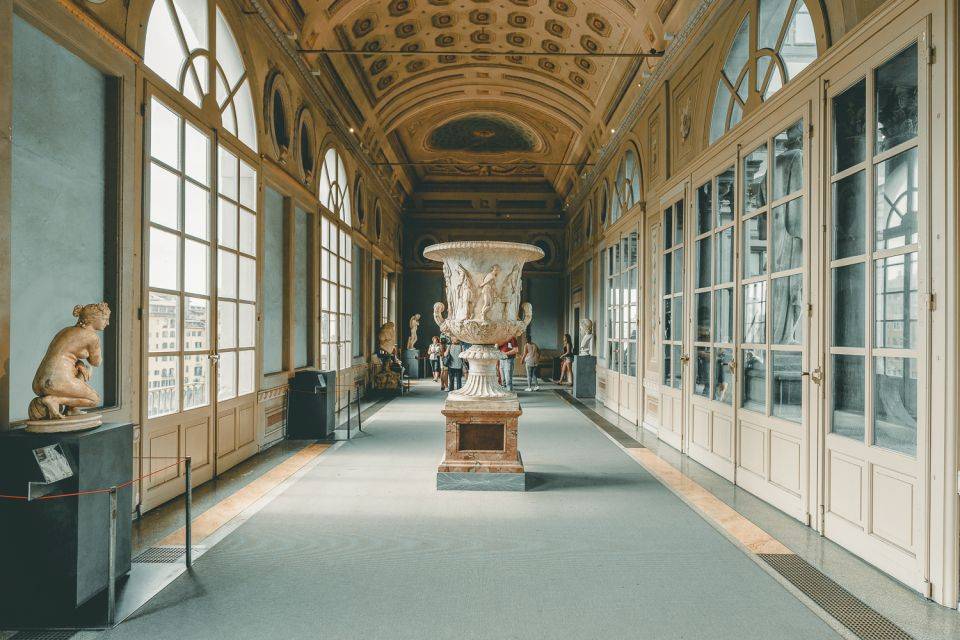A trip to Florence, a small city where the Renaissance was born, would not be complete without taking the Uffizi Gallery tour. You can see famous painters’ works there, including those by Botticelli, Da Vinci, Michelangelo, Caravaggio, and others.
Given its extensive history, it is highly recommended that you take a guided Uffizi Gallery tour. It enhances the understanding and illumination of this remarkable work of art. Having said that, you can certainly finish it by yourself! Just remember to let your jaw drop in front of these Uffizi Gallery must-see wonders!
1. Birth of Venus by Sandro Botticelli
The Birth of Venus, one of the most famous Renaissance paintings ever created, was painted by Sandro Botticelli between 1482 and 1485 for the Medici family. Venus, the goddess of love, is shown standing on a seashell in the centre of the picture. She is being blown to the shore to her right by Zephyr, the god of the west wind. The goddess of spring, Pomona, is waiting with a cloak prepared to envelop the new deity. Take a moment to take in the beauty of this magnificent piece of art.
2. La Primavera by Sandro Botticelli
La Primavera, which means “Spring” in English, is regarded as one of the greatest paintings ever produced. That comment goes beyond simply artistic merit and creative expression. La Primavera disregarded limitations on artistic expression, which may have resulted in a major development in art history. Some of the greatest performers who have ever lived followed the career of Botticelli. The Birth of Venus is unquestionably better known than La Primavera. The latter, however, is thought to be a more challenging and intricate work of art. The La Primavera field contains between 150 and 200 distinct species of flowers, each of which is individually painted. Botticelli painstakingly added intricate detail to this masterpiece.
3. The Holy Family With a Young St. John the Baptist By Michaelangelo
To say Michelangelo was a superb artist is an understatement. Because he was born with talent, he dedicated his entire life to becoming the best. Nevertheless, he believed that painting was the “lesser” of the arts. He felt that no mistake made by marble sculptors could be concealed or undone. Painters, on the other hand, had access to a wide range of techniques. But he still has a few paintings in his possession. Doni Tondo, commonly known as The Holy Family, is one of the few free-standing (panel) paintings on which Michaelangelo worked. It seems to be the sole panel that he completed. Agnolo Doni, a businessman, ordered it to commemorate the birth of his child.
4. Caravaggio’s Medusa
Cardinal Francesco Maria Bourbon del Monte hired Caravaggio in 1597 to create a painting of Medusa, which he then forwarded to Grand Duke Ferdinando I of Medici. In Greek mythology, Medusa was a Gorgon with deadly snakes for hair and the power to turn anybody who looked at her into stone. The goddess Athena gave Perseus a shield so he wouldn’t have to watch Medusa as he severed her head from her body. The picture by Caravaggio shows Medusa being beheaded after realizing that her head and body are no longer one.
5. Venus of Urbino by Titian
Titian completed The Venus of Urbino somewhere around 1538. Guidobaldo II Della Rovere, the Duke of Urbino, commissioned the painting as a gift for his young wife. It represented motherhood, sexuality, and faithfulness as an analogy for marriage. Venus, the goddess of love, is portrayed as sensuous. The dog at her feet is a metaphor for marital fidelity. The girl in the background who is closely examining the chest demonstrates motherhood.
6. Annunciation by Leonardo Da Vinci
The Annunciation was produced by Leonardo Da Vinci and Andrea del Verrocchio between 1472 and 1475. In the scenario, it can be seen that the Virgin Mary was informed by the Angel Gabriel that she would conceive and give birth to a son they would name Jesus. At the time, this idea was frequently emphasized in paintings. Watch for the flowers that the angel is holding. They are an intriguing feature that symbolizes Mary’s virginity.
7. Raphael’s Madonna Del Cardellino
Raphael (Raffaello in Italian) created the Madonna del Cardellino, often known as the Madonna of the Goldfinch, in 1506 as a wedding gift for his friend Lorenzo Nasi. The Madonna is portrayed as being young and beautiful in the piece. She wears a red and blue outfit. The church is represented by the colour blue, while the colour red stands for Christ’s zeal. Christ and John are still extremely little newborns.
Read more: 7 Things to explore about the Uffizi Gallery




